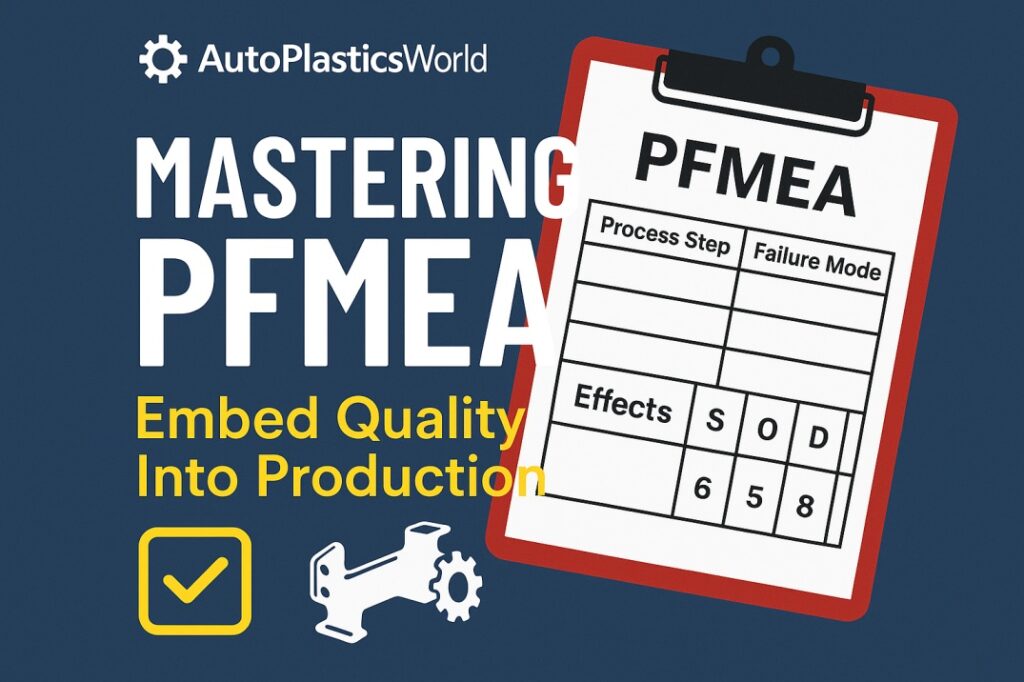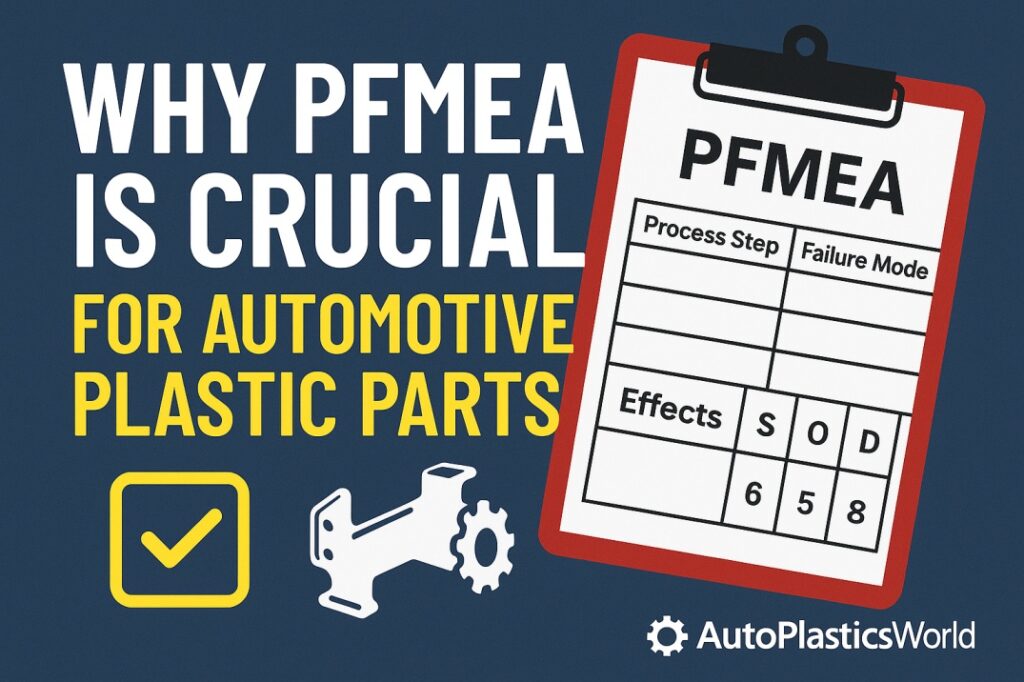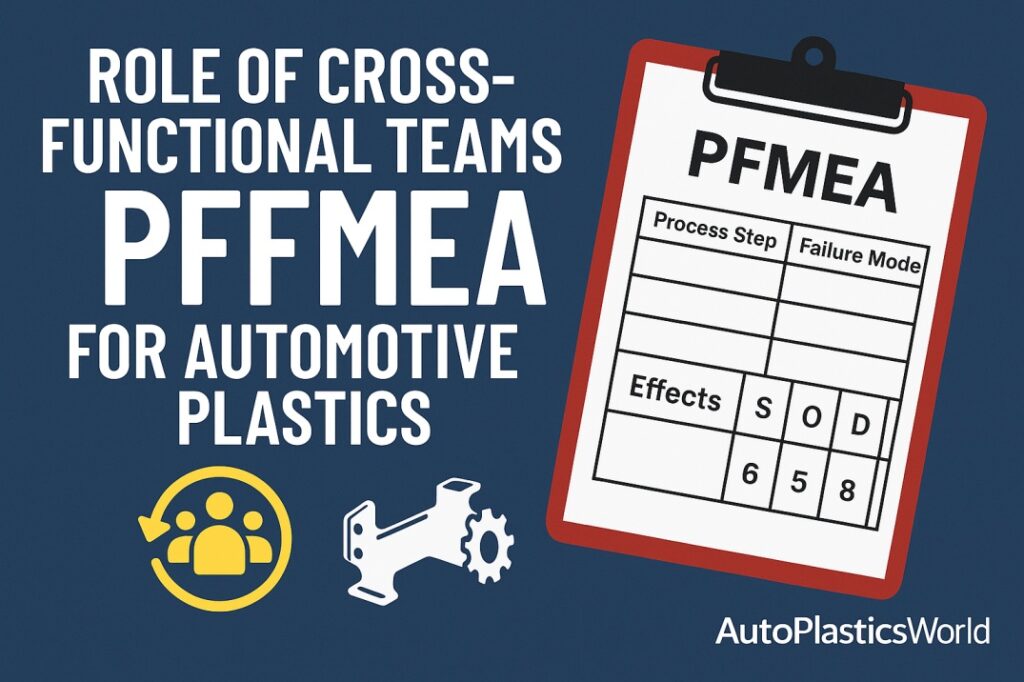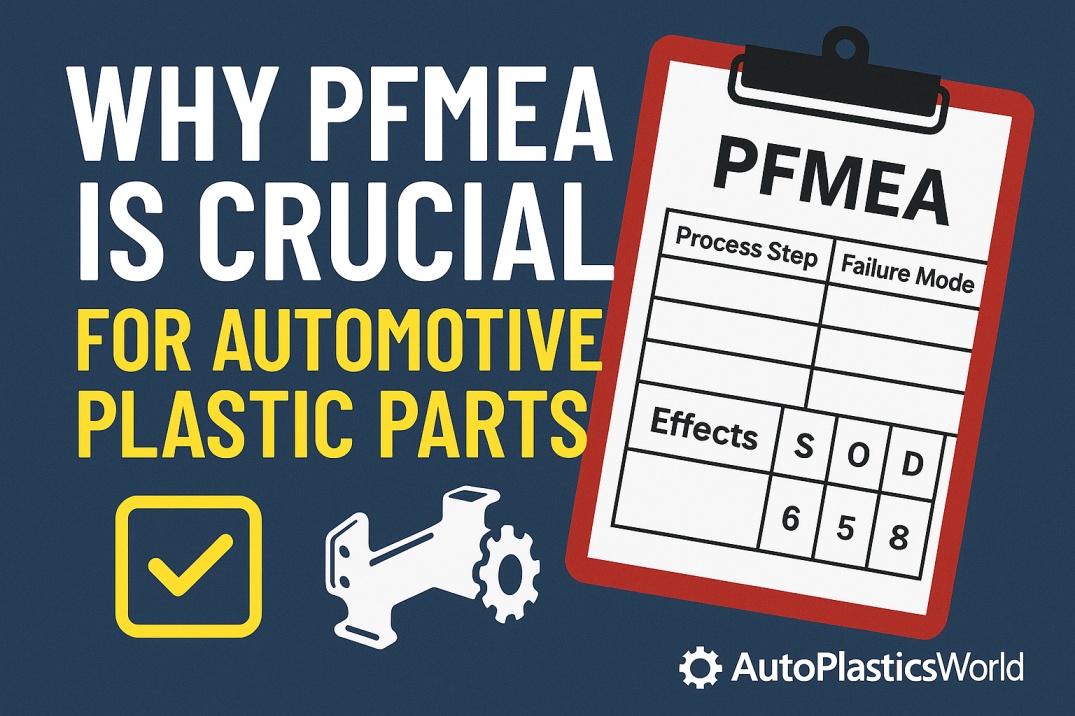In the world of automotive manufacturing, quality and reliability are non-negotiable. As vehicles grow increasingly complex, the demand for robust risk management tools has intensified. Process Failure Mode and Effects Analysis (PFMEA) has emerged as one of the most essential methodologies in quality control—especially within the automotive plastics sector. This guide aims to provide engineers, quality professionals, and production specialists a deep understanding of PFMEA, tailored specifically for the plastic components used in automobiles.
At AutoPlasticsWorld, we believe mastering PFMEA isn’t just about ticking boxes—it’s about embedding quality into every fiber of the production process.
Introduction
PFMEA is a method that helps find and fix possible problems in a manufacturing or assembly process before they actually happen in real situations. Unlike DFMEA (Design FMEA), which focuses on product design, PFMEA zeroes in on the processes used to manufacture a component, making it especially relevant in automotive plastics where molding, trimming, joining, and assembling steps are susceptible to variation.

Why PFMEA is Crucial for Automotive Plastic Parts
Automotive plastics are used extensively in dashboards, bumpers, interior trims, fuel tanks, and under-hood components. Failures in these parts, caused by process variation or lack of controls, can lead to:
- Cosmetic defects
- Structural weaknesses
- Improper fits or tolerances
- Regulatory non-compliance
A well-executed PFMEA not only reduces these risks but also saves time and cost by preventing late-stage defects.
At AutoPlasticsWorld, our specialists emphasize that PFMEA should be integrated early in the process development phase, not after the tools are built.

PFMEA Structure: Step-by-Step Breakdown
Here’s how engineers should approach PFMEA for plastic automotive parts:
Process Flow Diagram (PFD) Creation
Start with a clear Process Flow Diagram. It should include:
- Injection molding
- Cooling
- Ejection
- Trimming
- Inspection
- Assembly (if any)
Each of these becomes a process step in the PFMEA table.
Identify Potential Failure Modes
For each process step, determine what could go wrong. For example:
- Molding: Short shots, flashing, sink marks
- Trimming: Overcutting, tool damage
- Assembly: Poor bonding, misalignment
Effects and Severity Rating
Next, document the effects of each failure. These are customer-facing or downstream impacts like:
- Poor aesthetics
- Vehicle part failure
- Safety compromise
Assign a Severity (S) rating from 1 (minor) to 10 (hazardous without warning).
Cause and Occurrence Rating
List the possible root causes, such as:
- Incorrect temperature setting
- Worn-out mold cavities
- Operator error
Assign an Occurrence (O) score, rating how likely the failure is to happen (1 to 10).
Current Controls and Detection Rating
Mention existing controls, such as:
- Vision inspection systems
- In-process SPC (Statistical Process Control)
- Operator checklists
Then rate the Detection (D) capability. A high D value (close to 10) means the process is less likely to detect the issue before it reaches the customer.
Risk Priority Number (RPN)
Calculate the RPN = S × O × D. Higher RPNs indicate a more critical failure mode.
Recommended Actions
Suggest process improvements for failure modes with high RPNs. This might include:
- Tooling redesign
- Automatic sensors
- Operator training
- Machine parameter locking
At AutoPlasticsWorld, our case studies show that reducing the Detection score through better automation can significantly cut down overall risk.
Role of Cross-Functional Teams

PFMEA should never be prepared in isolation. A strong PFMEA team includes:
- Process Engineers
- Quality Engineers
- Tooling Engineers
- Production Supervisors
- Maintenance Experts
This diverse input helps capture real, practical risks that might be overlooked otherwise. At AutoPlasticsWorld, we encourage customers to organize PFMEA workshops during every new mold launch phase.
Integrating PFMEA with Other Tools
PFMEA is most effective when linked with:
- Control Plans – Based on PFMEA, control plans define process checkpoints and inspection frequencies.
- MSA (Measurement System Analysis) – Ensures that the tools and instruments used in detection are reliable.
- SPC (Statistical Process Control) – Provides real-time data to track variations and maintain stability.
We at AutoPlasticsWorld recommend that the PFMEA be reviewed and updated along with every process change, customer complaint, or internal non-conformance.
Common Mistakes in PFMEA Implementation
Even experienced engineers make PFMEA mistakes. Avoid the following:
- Using generic failure modes without digging into part-specific issues.
- Not updating PFMEA after engineering changes.
- Treating PFMEA as a one-time document instead of a living tool.
- Ignoring less obvious effects, like increased cycle time or operator fatigue.
- Assigning incorrect RPNs just to show improvement, rather than reflecting true risk.
Engineers on AutoPlasticsWorld forums often share how these errors can lead to critical failures even in reputed OEM supplies.
PFMEA in Context of IATF 16949
Automotive plastic part suppliers must comply with IATF 16949, which mandates risk analysis and continuous improvement. PFMEA is one of the mandatory core tools along with:
- APQP
- Control Plan
- MSA
- SPC
- PPAP
A well-maintained PFMEA aligns with clauses related to:
- Design & Development Planning
- Control of Production
- Nonconformance and Corrective Action
AutoPlasticsWorld offers PFMEA templates and gap-check tools aligned with IATF standards to help organizations achieve compliance with confidence.
Digital PFMEA Tools and Software
Gone are the days of PFMEA on Excel sheets. New software tools make it easier to do calculations, connect with control plans, and show high-risk areas visually.
Popular tools include:
- AIAG-VDA FMEA Software
- Siemens Polarion
- APIS IQ-FMEA
- Microsoft PFMEA Add-ins
At AutoPlasticsWorld, we also review and compare digital PFMEA tools suitable for small- to mid-sized plastic parts manufacturers.
Benefits of PFMEA in Automotive Plastics
The benefits are both tangible and strategic:
- Lower PPM (parts per million) rejection rates
- Faster root cause analysis
- Enhanced customer trust
- Improved internal communication
- Safer manufacturing environments
Plastic components are especially prone to cosmetic defects (sink marks, burn spots, short shots), and PFMEA helps minimize rework and scrap rates, leading to better profitability.
Real-World Case Study: Trim Panel Warpage Issue
A Tier 1 supplier was experiencing warpage in door trim panels during hot summer months. Using PFMEA, they identified the root cause as inconsistent mold cooling due to hard water scale buildup.
PFMEA helped:
- Rate the severity (high, due to assembly issues)
- Map the occurrence (moderate, only during summer)
- Improve detection (manual inspection changed to vision-based system)
This led to implementing automated mold temperature monitoring and a cooling line maintenance schedule, saving nearly ₹12 lakhs annually.
Shared exclusively on AutoPlasticsWorld, this case study is a prime example of PFMEA’s power in plastics.
Future of PFMEA in Automotive Plastics
The PFMEA process will evolve in the future with:
- AI-driven failure prediction
- Real-time sensor data integration
- Digital twin technology
- Dynamic FMEA updates
As vehicle designs become lighter and smarter, the automotive plastics industry will face tighter tolerances and complex geometries—making PFMEA even more critical.
Final Words for Engineers
PFMEA is not just a quality tool—it’s a mindset. When implemented effectively, it helps engineers prevent problems rather than fix them. For plastic parts used in high-volume automotive production, it becomes the backbone of risk control.
At AutoPlasticsWorld, we continually support engineers with up-to-date resources, training material, and case studies to enhance their PFMEA implementation. Whether you’re a new engineer or a seasoned quality professional, mastering PFMEA in automotive plastics is a career-defining capability.
FAQ’S
How often should a PFMEA be reviewed?
Every 12 months or whenever a process, part, or tool undergoes a change.
Is PFMEA required for existing running parts?
Yes, especially if issues arise or customer complaints are reported.
How do I justify PFMEA investment to management?
Show projected cost savings through reduction in rework, scrap, and customer returns.
Can I use a DFMEA as a PFMEA template?
No. DFMEA focuses on product design, while PFMEA is process-specific.


I do believe all the ideas youve presented for your post They are really convincing and will certainly work Nonetheless the posts are too short for novices May just you please lengthen them a little from subsequent time Thanks for the post
sure, i will take this suggestion in my upcoming blogs.
Excellent read, I just passed this onto a friend who was doing some research on that. And he just bought me lunch as I found it for him smile Thus let me rephrase that: Thank you for lunch!
I have been examinating out some of your posts and i can claim pretty clever stuff. I will make sure to bookmark your website.